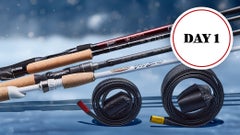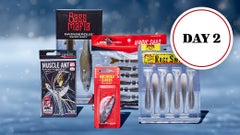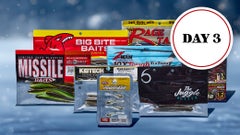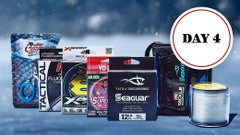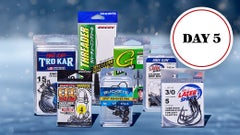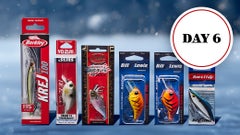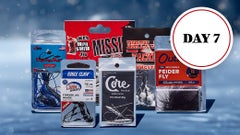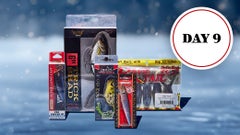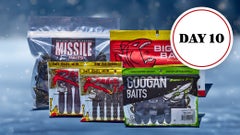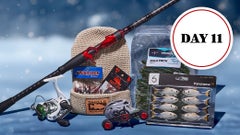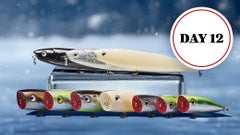Randall Tharp Wins FLW Red River Forrest Wood Cup
Randall Tharp's Winning Pattern, Baits & Gear
Tharp's preparation for the Cup essentially started back in April, when he fished the Central Open at the Red River. He was 2nd after day 1, 3rd after day 2 and wound up 4th. Being able to feel out where the fish were living then gave him an idea of where they might be in mid-August. "It's helped me a pretty good bit," he said. "I learned a lot. I've only been to this place four times and it helped me a lot because I really started to understand it. I fished some of the same water with a similar technique. I fished that area up the river in April. I didn't catch any big ones up there then, but I was using it for the same thing. I would go up there and catch a limit like that. It was really easy. It was a little more difficult now. I don't think the fish are as big, but they're still in there." He came back for 3 days of pre-practice this summer and focused on the same areas, including a lake off the main river that ran into a housing subdivision north of Red River South Marina and Resort, as well as a pocket that juts to the north off Port Lake near the launch ramp. He struggled one of the days, but caught 20 pounds in about 30 minutes in the pond near the ramp on a frog. That gave him a feel for the quality that resided there. "It was daylight to dark. It was 100 degrees," he said. "Two days I just wasted because I had to get stuff out of my system. I wasn't going to pre-fish because I feel really comfortable here. Then I started thinking because I knew Wesley (Strader) caught them up below Caddo dam (and finished 2nd in the Open). I just wanted to go up there and see it. So I went there and knew it wouldn't be won up there because all you can catch is little spotted bass. I think every fish in that river was on a bed at the time. "I spent a day in Pool 4 and to me it's the prettiest place on the river because it has a lot of milfoil and stuff I like to fish. I didn't get the bites down there to justify going down there. I was surprised more people didn't go down there. When we fished the Tour event here, half of the boats at least went. I fished Pool 5 in the Open this year and almost won. I just felt like that was maximizing my fishing time. I knew the bite was tough. "The third day I was here," he continued, "in that pocket by the boat ramp I hadn't had a frog bite the whole time I was here. In 30 minutes in there, I had 20 pounds, including an 8-pounder. It's always had fish in there every time I've been there, but in the Open I wanted to fish it and there were eight boats in there. It wasn't covered in pads then." On the final day of official practice, Tharp came off the water before dinner time, foregoing the final couple hours of daylight to prepare his boat and tackle for competition while many other competitors were still out on the Red. He had a confident look about him and was convinced he was on fish that could put him in contention if everything went his way.
Competition:
When the event started, the dock talk centered around 12 pounds being considered a decent bag of fish and anything in the teens could put someone near the top of the leaderboard. However, a cold front that came through on Wednesday certainly changed how some areas ultimately set up for the anglers. "It was definitely more of a challenge," Tharp said. "I was averaging 40 to 50 bites a day in practice. I just think the fish here like the hot weather. Every afternoon is when I'd get my big bites." Tharp's tournament did not get off to a smooth start. Other tournament boats covered up his first two spots and he didn't have a fish in the boat until 10 a.m. He did all of his damage in the afternoon, catching several good fish out of the pocket near the ramp. "Several other boats were in there," he said. "I know this because my wife stood on the bank and watched, waiting for me to get in there. Anyplace like this, the fish like to stay in the backwater for some reason. It's just a release area and it's loaded with them. I don't know why the big ones don't swim to the river. They like to stay in there." His 18-08 bag was reminiscent of the 21-15 effort Jacob Wheeler put forth on day 1 last year at Lake Lanier that helped carry him to victory. He came back Friday with 11-03 he called it an "average day" and extended his lead to 4 ounces over Thrift heading into the weekend. He got on a morning bite in Haven Lake upriver and had a limit fairly early, including a couple solid fish. His afternoon bite was a struggle, a contrast from day 1, but he started to understand more about where he needed to be and when. "I found those big fish on the afternoon of the last day (of practice). I caught 20 pounds in 30 minutes. I knew then it was something special."
Winning Pattern:
The subdivision lake off the river is essentially a 3- to 6-foot deep channel that opens up in the back with plenty of shoreline cover to flip or pull a swimjig or frog through. There were also stretches of small riprap banks and several docks, but those weren't much of a factor without much deep water nearby. It's typically not a big-fish hole, but Tharp caught numbers and ran into a couple of bonus 3-pounders along the way. He did fish a few main-river spots, focusing on rock jetties or anything that current washed over, but his main deals were off the river and in backwaters. He dipped below 10 pounds on Saturday, but his 9-07 bag only dropped him 4 ounces back of Thrift. His confidence wasn't shaken because he knew he'd have his two main areas to himself on the final day. He spent the first 3 hours of the day in his limit area, working the perimeter of the narrow lake for a handful of bites, including one close to 4 pounds that fell for a frog. He threw a square-bill crankbait along the rocky banks and then would pick up a swimjig when wood or grass were present, twitching the rod constantly with each crank of the reel. He had another fish of comparable quality roll on the swimjig, but it never opened its mouth and didn't get the bait. From there, he wiggled his way back into the pad-filled pond that's visible from the launch ramp. It was a painstaking process to fish around in there, but about 30 minutes after he got in there, he stuck his first of two upgrades with his wife, Sara, watching from shore. After another lull, he stuck another frog fish that helped get him to 14 pounds. "I caught seven fish (Sunday)," he said. "I probably had 12 bites and I didn't make a mistake. "It's a shallow-water fishery and these bass stay shallow all year here," Tharp said. "It's the dead of summer and I caught most of my fish in 2 feet or less. I fished in a lot of the same places that I did when I was here before."
Winning Gear:
Swimjig gear: 7'6" heavy-action Halo Fishing Twilite casting rod, Shimano Chronarch casting reel (6.2:1 ratio), 50-pound Gamma Torque braided line, 3/8-ounce 4x4 Jigs swimjig (green-pumpkin head, homemade bream pattern skirt), Strike King Rage Craw trailer (green-pumpkin). Mark Horton fished with Tharp in pre-practice and had success with a Strike King swimjig, but it was a color pattern Tharp usually doesn't throw. "I prefer black and blue or white, but he was catching them on a green-pumpkin swimjig," he said, noting the skirt mimicked a bluegill. He eventually tied up a skirt himself to closely resemble the one Horton had and it turned out to be his most consistent producer in the tournament. "There's no doubt that I probably never would've tied that jig up if it wasn't for the bites he got on the Strike King bait," he said.
Square-bill gear: 7' medium-action Halo Fishing Twilite cranking rod, Shimano Core Mg casting reel, 14-pound Gamma Edge fluorocarbon line, Lucky Craft RTO 1.5 silent square-bill crankbait (crack black).
Frog gear: 7'6" extra -eavy Halo Twilite casting rod, same reel as swimjig, 65-pound Gamma Torque braided line, SPRO Bronzeye 65 (Navy seal) or Spro Bronzeye Jr. (tropical white).
Main Factor: "It was extremely important to get off to that start. Everybody was speculating before it started that if you could catch one big bag, you might be able to ride that to the win. I didn't know how it would go down, but I wound up catching two big bags, including that 14 on the final day. I think everybody was surprised it took that much weight to win."
Performance Edge: "All of my sponsors are extremely important, but two things stood out for me. Going to that extra-heavy Halo rod on day 4 was critical. I'm not sure I would've been able to land those good ones without changing from the heavy-action to that rod. Also, my Power-Poles were definitely a necessity, especially in the afternoon places I fished. It helped me slow down."
Forrest Wood Cup Winning Pattern Bassfan 8/20/13 (Todd Ceisner)
Jacob Wheeler's Pattern, Baits & Gear
Wacky-rig gear: 7'1" medium-action G. Loomis NRX spinning rod, Shimano Stradic Ci4 3000 spinning reel, 10-pound Sufix 832 braided line, 15-pound Sufix Castable Invisiline fluorocarbon line (leader), 2/0 VMC Wacky Weedless hook, 5 Trigger-X Flutter Worm (watermelon red).
Frog gear: 7'2" medium-heavy Shimano Cumara casting rod, Shimano Core Mg 100 casting reel, 65-pound Sufix 832 braided line,SPRO Bronzeye 65 frog (nasty shad).
Main factor: "Just sticking to my guns and with the baits that worked after I realized how the fish had changed."
Performance edge: "Because I was switching baits so much in practice, I needed to keep organized and my Plano boxes were key for that. My Evinrude started every time. I bent four props this week running over stuff, but just knowing that it's going start up after running over the nastiest stuff give me a lot of confidence. Also that Sufix braid was big, knowing that I could get those out of that heavy cover. That was my life line to those fish."
Forrest Wood Cup 2-5 Patterns Bassfan 8/21/13 (Todd Ceisner)
Bryan Thrift's Pattern, Baits & Gear
Shaky-head gear: 6'10" medium-action unnamed spinning rod, unnamed spinning reel, 15-pound unnamed braided line, 10-pound P-Line fluorocarbon line, 1/8-oz. Evercast Lures shaky-head jig, 6.5" Damiki Finesse Miki worm (watermelon candy), Zoom Trick Worm (green-pumpkin green) He dyed the tail of the Finesse Miki chartreuse to make it stand out.
ChatterBait gear: 6'9" medium-heavy unnamed casting rod, unnamed casting reel (7.1:1 gear ratio), 20-pound P-Line fluorocarbon line, 1/2-oz. Z-Man ChatterBait (brown/black), fluke-style trailer. He threw the ChatterBait along the bank and got 90 percent of the bite off some sort of rock. "I'd put the trolling motor on high and just down the bank. Every now and then I'd hit a little pod of fish. You could go and go and get nothing, but then you'd get a bite and then catch five or six real quick. They were just in little wolk packs cruising down the rocks. I thought it was just fluke deal the first day."
Main factor: "Just the combination of finding those places where a group of fish might set up and that 1/8-ounce Evercast Lures shaky-head and the Damiki Finesse Miki Worm."
Performance edge: "That Damiki Finesse Miki worm and the 10-pound P-Line Fluorocarbon. I caught that 7 1/2-pounder on a shaky-head with 10-pound line dragging him over stumps and through trees.
Forrest Wood Cup 2-5 Patterns Bassfan 8/21/13 (Todd Ceisner)
Kerry Milner's Pattern, Baits & Gear
Flipping gear: 7'4" heavy-action St. Croix Legend Tournament casting rod, unnamed casting reel, 50-pound PowerPro braided line, 3/8-oz. unnamed tungsten weight, 3/0 and 4/0 Gamakatsu EWG Superline worm hook, Zoom Brush Hog and Baby Brush Hog (red flake and green-pumpkin magic). He flipped the red flake brush hog early in the morning and after the sun got higher, he went with the green-pumpkin magic.
Shaky-head gear: 7'1" St. Croix Legend Tournament spinning rod, Shimano Stradic FJ 2500 spinning reel, 8-pound unnamed fluorocarbon line, 1/8-oz. homemade jig, Zoom Trick Worm (green-pumpkin and watermelon candy). He went to 20-pound fluoro when tossing the shaky-head around in the backwaters.
Frog gear: 7'6" medium-heavy St. Croix Legend Tournament casting rod, Shimano Curado casting reel, 65-pound PowerPro braided line, SPRO Bronzeye Jr. frog (rain forest black).
Main factor: "The amount of time I spent here practicing. I decided to stay close even though I strung my practice out over all three pools somewhat. I learned that quality would be really hard to find so I stayed close."
Performance edge: "That Ranger boat of mine has been slid over so many stumps, it has to go to Ranger next week without a doubt. My Evinrude performed great as well."
Forrest Wood Cup 2-5 Patterns Bassfan 8/21/13 (Todd Ceisner)
Larry Nixon's Pattern, Baits & Gear
Flipping gear: 7'3" medium-heavy Dobyns Champion 735 casting rod, unnamed casting reel, 17- and 20-pound Seaguar AbrazX fluorocarbon line, 5/16- and 3/8-oz. Gambler tungsten flipping weights with rattles, 4" Gary Yamamoto Custom Baits Kreature (blue pearl silver flake). He opted for a white soft plastic to match the baitfish in the areas he was fishing. He also dyed the tail chartreuse. "These were are really on shad and I found if flipped a shiny white bait I could get bit behind other boats," he said. "I caught big ones on the river and I don't think think anyone else caught a big one on the river." He caught his bigger fish on day 4 on a frog.
Main factor: "I put 7 days in fishing the river and I'm really learning this thing pretty good. I practiced pretty hard and had some good areas and spent a lot of time doing what I like to do. The main thing was I figured out just how tough it is and it gave me a lot of patience."
Performance edge: "My MinnKota (trolling motor) was pretty stout. It pulled me off of a lot of stuff (Sunday). It's a nightmare to troll around out there. Also, those Dobyns rods, are without a doubt, the best I've ever used."
Forrest Wood Cup 2-5 Patterns Bassfan 8/21/13 (Todd Ceisner)





















